Snow White (2025) or: How I Learned to Start Worrying and Miss the 2010s
One man's 5/10 is another man's breath of fresh air.
Everyone responds to periods of crisis in their own special way.
With the world ablaze and a quarter-life crisis underway, I’ve found myself responding in the healthiest conceivable way: revisiting the middling-to-failed blockbusters of the 2010s.
After months of exposure to advertisements for Marc Webb’s supernaturally cursed Snow White, I (somewhat morbidly) turned my focus to Hollywood’s last attempts to bring the Grimm character to life. On May 30, 2012, two extremely normal directors with regular careers1 released Mirror Mirror and Snow White and the Huntsman.
Maybe I’ve fallen victim to nostalgia, but in these two messes, I saw a level of creative conviction that simply isn’t present in today’s big-budget spectacles. While neither adaptation can be called great cinema, they can help illustrate how far we’ve fallen from even the drivel of the last decade.
Mirror Mirror

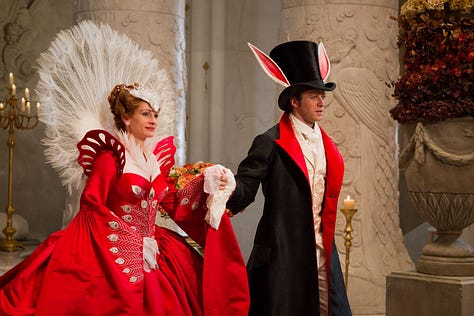
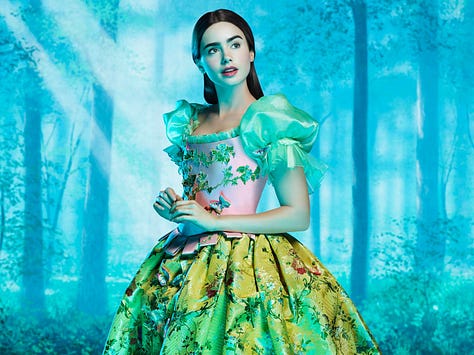

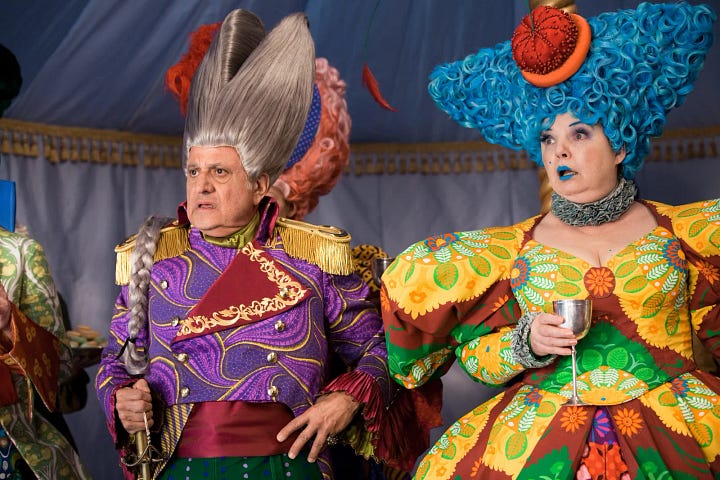
The first of the 2012 adaptations is best seen as a highlight reel for the late, great costume designer, Eiko Ishioka. Mirror Mirror is the fourth and final collaboration between Ishioka and director Tarsem Singh, of The Fall and Beyoncé/Britney Spears/P!nk Pepsi Super Bowl commercial fame.
Marrying elegant lines to candy-colored fantasy, Ishioka’s work is unlike anything in Disney’s later live-action fairy tales. It’s almost troubling to see such fearless artistic vision in the center of this film. Even the set design seems like it’s trying to match the costumes’ sense of storybook artifice, erring on the side of theme park design every time.
Oh, and there’s a script too. Following a clichéd but good-looking animated prologue, the story centers on Snow White’s journey to independence from her stepmother, here named simply Evil Queen (it’s cleaner). Along the way, she meets a gawky prince, a scrappy band of thieving dwarves, and other public domain elements you know from the fairy tale. What you might not expect are the following story beats:
A deadly, unseen beast lurks in the dark forest, keeping the kingdom’s citizens from escaping the Evil Queen’s reign.
A dwarf seeks the affections of Snow White.
Snow White is a talented fencer and thief, featuring a poofy Renaissance Faire costume change.
The Evil Queen needs to remarry to relieve the kingdom’s financial turmoil.
But much of the flabby plot, including Snow White’s emotional arc, is just a creaky frame on which the director can hang dwarf-related hijinks and uncomfortable one-sided flirting scenes between Julia Roberts’ Evil Queen and Armie Hammer’s Prince Alcott.
Roberts is the biggest star here, and you can feel some stilted preciousness around her character. She is presented as vain and artificial, but never unsightly. She is mean, but never believably cruel. Roberts is a legendarily charismatic performer, but she does little to enhance this underwritten character. Hammer gives a predictably bland performance, which, we can now say without hesitation, is the least of his problems.
A relatively bright spot is Lily Collins in the lead role. Mirror Mirror does not have much to say about Snow White, opting to base her character around traits like “beautiful” and “dad presumed dead.” Somehow, Collins brings charm and lightness.
If there is a second reason, beyond costuming, to watch this mess, it is Collins’ performance of a baffling Bollywood-style musical number from the end credits. “I Believe In Love - Mirror Mirror Mix” currently has 5,684,712 streams on Spotify, soon to hit 6 million if I have anything to say about it. One can only dream of end credit tie-in songs as inexplicable as this2.
Mirror Mirror isn’t very concerned about being a functional film, and maybe that’s for the best. In a landscape of Disney remakes that extend 80-minute children’s films into two-hour monstrosities, levity is a much-needed change of pace. Singh has no passion for his characters and a boundless love for his costumes. But with this script and these costumes, who can blame him?
Snow White and the Huntsman
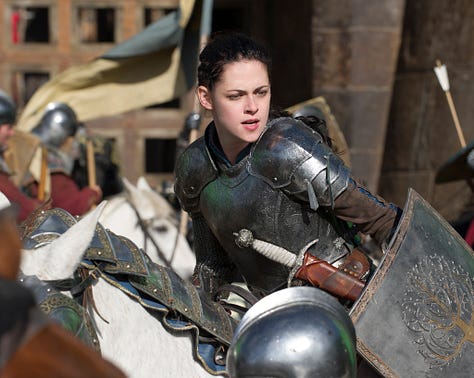
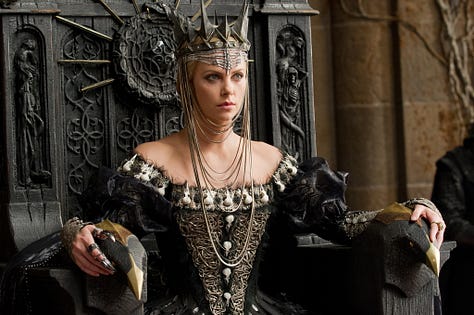
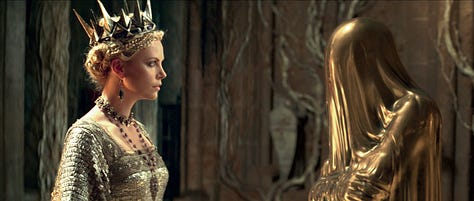
My tour of 2012 Snow White adaptations comes to a close with the better of the two. Unlike Mirror Mirror, Snow White and the Huntsman is trying very hard to be an expansive story, full of jaded characters with tragic backstories. The keyword here is “trying.”
This is the first release of Rupert Sanders, who in his now 13 years as a Hollywood director has yet to make a film that isn’t a remake or reboot. His story sense is unsurprisingly limited, but his gifts as a visual stylist almost entirely make up for it. If you’re as easily swayed by a well-deployed design budget as I am, it’s an engaging watch (maybe more of an engaging look).
Kristen Stewart and Charlize Theron lead the cast as Snow White and the evil queen, respectively, and frankly, they both deliver. As written, Stewart’s Snow White doesn’t have much dramatic material to play in, but her action sequences and quieter moments hold a sensitive power that can be seen in her later work on stylish dramas like Spencer and Love Lies Bleeding. Theron brings signature intensity and an inimitable presence to her role, supported to no end by Colleen Atwood’s jaw-dropping gowns. Never before have bird skulls and dung beetle shells looked so chic.
The script, however, is an unfortunate byproduct of Tim Burton’s mega-hit “reimagining” of Alice in Wonderland, released just two years prior (also the brainchild of producer Joe Roth). Like Alice, Sanders’ film attempts to structure and justify magic and absurdity, albeit with less exhausting results.
The worst offense in this matter is the backstory of Theron’s evil queen, here named Ravenna. Her scary name shows us, the small-minded audience, that the queen is more than just a title. We’re told that a sorceress enchanted Ravenna in her childhood to remain young and beautiful forever. Ravenna would go on to use her charms to topple kingdoms and amass power. When her villainy is revealed on her wedding night to the king, it’s revealed that she’s been spurned by kings before, and will stop at nothing to exact a generalized revenge on any kingdom in the future.
Though Theron plays her as a woman being torn apart from the inside, it’s a major disappointment that this figure of such power, both magically and dramatically, is motivated only by insecurity and spite for her exes. There’s no inner turmoil written into her character, no real interrogation of the insidious value men put on women’s youthful beauty. This wouldn’t be so frustrating if the parts weren’t laid out so clearly in the backstory, nor if Theron weren’t giving such an engaging performance.
Another unfortunate holdover from Alice is the addition of a prophecy. A blind dwarf played by Bob Hoskins3 sees that Snow White is the “one” to overthrow the evil queen’s reign. The filmmakers are also quick to correct the idea that “fairest of them all” is a strictly physical title, stating that fairness must also be present in the heart (close call). These sorts of awkward, cloying qualifications make one wonder why studios would even want to make a fairy tale (it’s money, it’s always for money).
Despite Sanders’ just-okay understanding of storytelling, his aesthetic sense is enchanting. Though this film does belong to the litter of “gritty reimaginings” of fantasy properties, it confidently avoids the flatness of its contemporaries. Striking a balance between historical heft and colorful fantasy, the kingdom feels lived-in but beyond our world. The magic conjured by Ravenna is frightening and sophisticated, all erratic obsidian shards and a malicious black goo4. There’s a vision here, even if it is in service of a cookie-cutter plot.
Snow White (The Webb Joint)
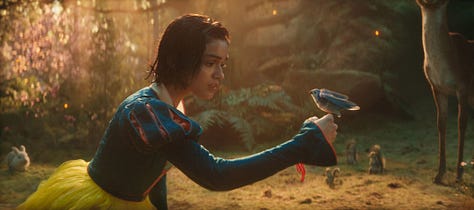

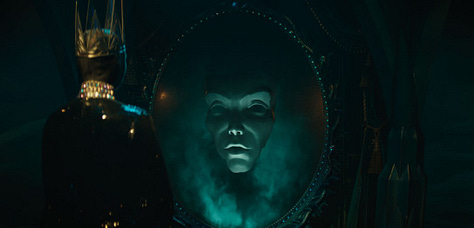
Despite the noxious cloud of high-profile controversies that hung over Disney’s proprietary adaptation of Snow White, it seems to have already disappeared from public memory. Watching the mega-budget Marc Webb tentpole feels like watching a conference call between Disney executives. There is a cynicism programmed into the very DNA of the film, cutting off the possibility of creative decisions before they can even come to fruition.
If you haven’t noticed, the value that I’ve found in the 2012 adaptations comes mostly from the boldness of their respective visual styles. There is no style here. There is merely the blueprint of the 1937 animated film, a beautiful object made by overworked legends eager to make history. No design in the film, from sets to costumes to the dwarves themselves, feels unique. There is only a sheen of garish, “photorealistic” CGI detail overlaid upon the original’s cartoon charm. It has to be some sort of crime to hire Sandy Powell to merely transpose animated designs to live action, especially after her stunning work on Kenneth Branagh’s Cinderella.
If Julia Roberts’ performance felt stifled by over-reverent stardom, Gal Gadot’s feels petrified by perfunctory fame. Sewed into a sequinned version of the animated film’s sleek robes, Gadot struggles to bring any humanity to the words she says. There is no fun in this performance, even when she’s given a glossy musical number about how conceited she is.
The revisionism of the 2012 adaptations continues here, only more sheepishly this time. At 100 minutes, Snow White is mercifully brisk. But the short runtime backfires when it decides to make the final showdown between the princess and the Evil Queen a conversation. The moment feels rushed and dramatically undercooked, especially when the supposedly humane revision is followed by the queen turning to stone and exploding.
There is perhaps no greater test of a rising star than surviving a bad movie, and Rachel Zegler passes with flying colors. In the middle of a film that is DOA, she brings a charm and humanity that is truly infectious. Add a soaring singing voice (free from the vocal manipulation of her co-star) and you have someone who can hold her own in a huge, unwieldy corporate product.
Thanks to a super-inflated budget and a general lack of interest from audiences, Snow White has been deemed a failure by both Disney and its critics. If this is what roughly $300 million can buy you, maybe it’s time to roll back the onslaught of remakes that plague multiplexes each year. Though the success of Lilo & Stitch may undo some of that ill will, we can only hope that studios learn to bring back the slightest modicum of artistry to their coffers of IP.
Not fact-checking this, of course.
Made possible by superimposing Hoskins’ face onto a real dwarf performer, sparking a controversy that I am not qualified to comment on intelligently.




